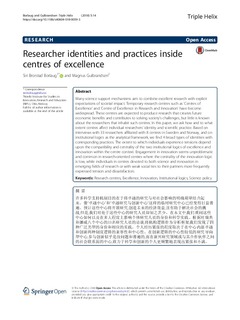Researcher identities and practices inside centres of excellence
Journal article, Peer reviewed
Published version

Åpne
Permanent lenke
http://hdl.handle.net/11250/2580131Utgivelsesdato
2018-12-20Metadata
Vis full innførselSamlinger
Originalversjon
Borlaug, S. B.; Gulbrandsen, M. (2018). Researcher identities and practices inside centres of excellence. Triple Helix. 10.1186/s40604-018-0059-3Sammendrag
Many science support mechanisms aim to combine excellent research with explicit expectations of societal impact. Temporary research centres such as ‘Centres of Excellence’ and ‘Centre of Excellence in Research and Innovation’ have become widespread. These centres are expected to produce research that creates future economic benefits and contributes to solving society’s challenges, but little is known about the researchers that inhabit such centres. In this paper, we ask how and to what extent centres affect individual researchers’ identity and scientific practice. Based on interviews with 33 researchers affiliated with 8 centres in Sweden and Norway, and on institutional logics as the analytical framework, we find 4 broad types of identities with corresponding practices. The extent to which individuals experience tensions depend upon the compatibility and centrality of the two institutional logics of excellence and innovation within the centre context. Engagement in innovation seems unproblematic and common in research-oriented centres where the centrality of the innovation logic is low, while individuals in centres devoted to both science and innovation in emerging fields of research or with weak social ties to their partners more frequently expressed tension and dissatisfaction.
